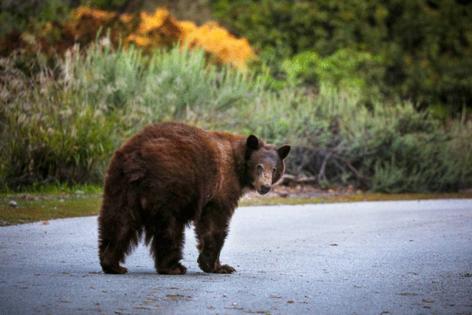Commentary: We know how to coexist with bears and wolves. Will we kill them instead?
Published in Op Eds
Humans have always had an emotional relationship with predators. We both revere and demonize them. We buy more than 100 million teddy bears annually for our children, while 50,000 real bears are hunted yearly in North America. Cultural fables and fairy tales simultaneously vilify and celebrate predators — from “The Lion King” to the Three Bears to the Big Bad Wolf.
In elementary school, we teach kids about the food chain and how every animal is crucial in maintaining a balanced ecosystem. Predators are often the entry point to understanding ecology for young minds, with an abundance of nature films about sharks, bald eagles, tigers and many more fascinating predators. Somewhere between elementary school and adulthood, we forget what predators teach us and how much we need them.
And it is this nation’s adults who need to reconcile their ideas about predators and decide if we truly want to live with the ones we once attempted to exterminate. Our capacity to erase predators is proven. Our ability to conserve and recover them is equally established. The fundamental question remains: Do we wish to live alongside them?
This age-old conflict resurfaced in California recently, igniting modern tensions. This spring, the Los Angeles Times wrote several articles on predator tensions, including a suspected black bear attack in Sierra County, conflict between farmers and a handful of wolves, and ranchers pressuring legislators for permission to “remove” wolves. Ranchers spotlighted these sparse examples with an ominous, documentary-style video online likening the severity of the issue to investigative crime reporting. This reporting paints a picture of an intensifying war between predators and those who would hunt them, if not for California law.
The reality is that these examples of predators affecting humans are extremely rare. However, these stories build up and fuel a societal bias known in psychology as the availability heuristic, whereby a person uses a mental shortcut to judge the likelihood of an event based on how easily examples come to mind. When our judgment is clouded in this way, we design wildlife policy driven by fear, not reason.
Images of a calf mauled by a wolf are evocative and ignite emotional responses. The same is true of an image of a wolf caught in a snare trap slowly suffering as it struggles to free itself. The conflict among wolves, prey and people is real. The question is how to manage it responsibly.
First, we need clarity on the actual harm done by predators, including wolves. Wolves do attack livestock, but statistically the risk of an individual cow being attacked by a wolf is less than 1 in 100,000 in any given year. In more than 125 years across North America, wolves have only ever killed two people. In contrast, Americans kill each other at an annual rate of 6.8 per 100,000 individuals. It is clearly safer to be cattle with wolves roaming about than it is to be a person in society. This is not to say a wolf mauling a calf is not a tragic loss for an individual rancher, but we need to reckon these sparse personal losses with the drastic ecological damage of hunting wolves to near extinction.
Today, there are approximately 6,000 to 8,000 gray wolves remaining in the contiguous U.S. (down from approximately 2 million). Wolves are known as “ecosystem guardians” or “keystone species,” meaning they are critical to maintaining ecosystem balance. When they are systematically removed, we see increases in livestock diseases, land degradation and food chain destabilization.
Given the rarity of actual wolf attacks, we must invest in solutions that protect both ranchers and predators. An example is Wisconsin Gov. Tony Evers’ proposal to include $3.7 million in the state budget for wolf monitoring and abatement projects. These nonlethal methods are the most effective way to ensure predators and humans coexist. According to U.S. Department of Agriculture data, nonlethal methods reduce wolf-livestock conflicts by an average of 91%.
Yet in 2023, USDA’s Wildlife Services devoted less than 1% of its $286-million budget to nonlethal efforts. Despite nearly equal preference among livestock producers for both approaches, the money overwhelmingly supports lethal control.
It is possible to create a future in which wolves, cattle and ranchers coexist with minimal harm. However, it is not possible to imagine a world in which one side “wins” outright without severe negative consequences. We have the resources to find a win for ranchers and a win for wolves — if the American people choose to do so.
____
Peter Kareiva, a former chief executive of the Aquarium of the Pacific in Long Beach and a former director of UCLA’s Institute of the Environment and Sustainability, is a founding member of Team Wolf, an organization focused on the long-term protection and recovery of gray wolves.
_____
©2025 Los Angeles Times. Visit at latimes.com. Distributed by Tribune Content Agency, LLC.

























































Comments